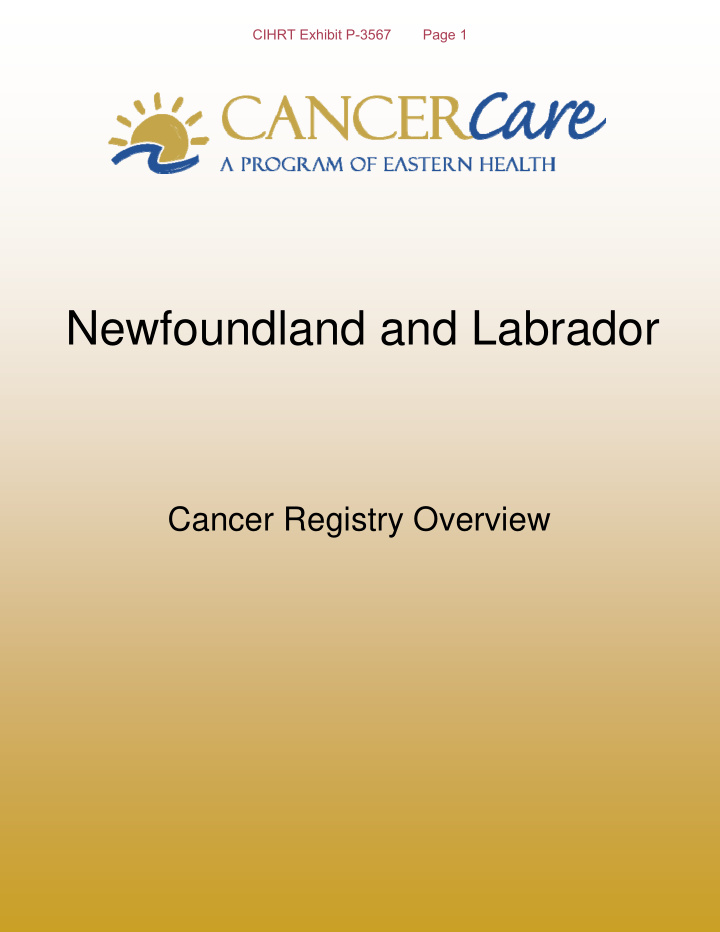



CIHRT Exhibit P-3567 Page 1 Newfoundland and Labrador Cancer Registry Overview
CIHRT Exhibit P-3567 Page 2 Purpose • Collect data for use in in surveillance, cancer control, research, policy development and decision making.
CIHRT Exhibit P-3567 Page 3 Resources • Registry Staff include – Coordinator – Three full time Cancer Registrars – One Temporary Cancer Registrar • Information Technology – None dedicated, but have one individual programmer analyst with various responsibilities
CIHRT Exhibit P-3567 Page 4 Staff Qualifications • All staff have completed a Health Records Technician Program • Upon hire to the Registry, staff must become a certified Cancer Registrar, through the National Cancer Registrars Association, Council on Certification (US based) • Annual attendance at Technical Workshops coordinated with PHAC and Stats Canada • Collaborative Stage Training (Coordinator is a trainer)
CIHRT Exhibit P-3567 Page 5 Process • Pathology reports sent electronically from laboratories across the province, with the exception of St. Anthony • Reports are received every Monday in the Cancer Registry • Cancer Registrars review the information and begin the registration process • Data elements identified through Canadian Council of Cancer Registries
CIHRT Exhibit P-3567 Page 6 Data Elements collected • Demographic information – name, date of birth, sex, health number, address, telephone number and next of kin • Case identification – site of cancer and histology, date of diagnosis, referring and diagnosing hospital, attending physician, attending oncologist, stage at diagnosis • Treatment – Date of first initial treatment
CIHRT Exhibit P-3567 Page 7 Collaborative Stage • Collaborative stage data is collected for four major disease sites – lung, colorectal, prostate and breast cancer • New process which began two years ago under the direction of the Public Health Agency of Canada, with input from the Canadian Council of Cancer Registries and Statistics Canada
CIHRT Exhibit P-3567 Page 8 Collaborative Stage Elements • Breast Cancer – Tumor size – Extension – Regional Lymph nodes examined – Regional lymph nodes positive – Metastases at diagnosis – ER/ PR and HER-2 Neu status as per pathology report
CIHRT Exhibit P-3567 Page 9 Data Submission • Annual Submission to Statistics Canada • Statistics Canada conduct a national death clearance process • Statistics Canada submit NL data to the North American Association of Cancer Registries • Annual publication in Canada
CIHRT Exhibit P-3567 Page 10 Data Quality • Edits run by Statistics Canada • If necessary, files come back to each province for correction • Data Quality indicators sent to each province for review. These include: – Timeliness of data submission – Coverage- completeness of case ascertainment – Accuracy of data – Completeness of data
CIHRT Exhibit P-3567 Page 11 Data Quality • Re-abstraction of collaborative stage data conducted • NAACCR certification process – NL has not received any level of certification for two reasons: • Case Ascertainment • Death Clearance
CIHRT Exhibit P-3567 Page 12 Death Clearance • Work in progress to implement a local death clearance process • Purchase of Linkage Wiz Software • Collaboration with epidemiologists and data analyst from Cancer Care Nova Scotia to implement • Now in final stages of implementation
CIHRT Exhibit P-3567 Page 13 Death Clearance • Complicated process, need to be able to match individuals in the Cancer Registry with individuals in the Vital Statistics file • Can use deterministic or probabilistic matching • At present, seventy percent of our data has been matched using a deterministic process
CIHRT Exhibit P-3567 Page 14 Death Clearance • Remaining cases under review • Issues may be duplicate MCP numbers, inability to match cases and matching cause of death
CIHRT Exhibit P-3567 Page 15 Case Ascertainment • Once death clearance is in place, we will be able to capture “Death Certificate Only” cases and improve capture • Working with Hematology Oncology to capture the hematology malignancies that may not have a pathology examination
CIHRT Exhibit P-3567 Page 16 Cancer Registry Data Use • Wait time reporting across the province • Research, following Human Investigation Committee Approval • Breast Screening indicators • Canadian Cancer Statistics publication • Program planning – at present, we have very limited analytic capacity and have asked for resources
CIHRT Exhibit P-3567 Page 17 Future plans • Atlantic Canada partnership established to facilitate education and ongoing quality improvement • Cancer Registry Advisory Committee to be established • Proposal to Canadian Partnership Against Cancer to initiate an electronic synoptic reporting process • Analytic Workshop to be held in January • Many improvements have resource implications, especially in terms of analytic capacity
Recommend
More recommend